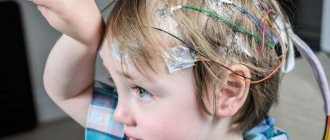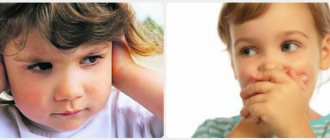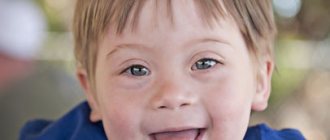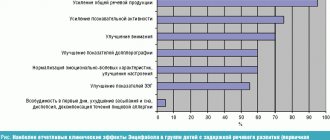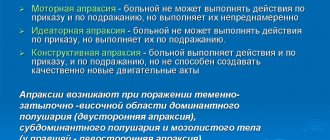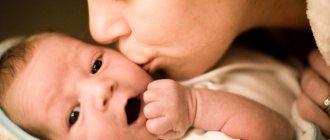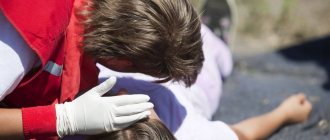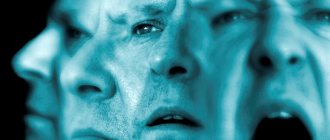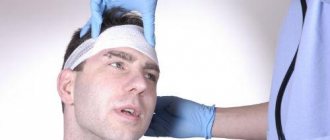Alalia in children is a systemic disease characterized by profound impairment of speech function, insufficient degree of its development or complete absence.
Alalia in children is a systemic disease characterized by profound impairment of speech function, insufficient degree of its development or complete absence. In this case, the patient’s hearing is not impaired, a decrease in the intellectual level is not initially observed and may be of a secondary nature.
Alalia must be differentiated from aphasia. With aphasia, the child loses speech function, but previously speech was present. With alalia, expressive or impressive speech is absent or significantly limited initially. This disorder is detected in approximately every hundredth child under 6-7 years of age; in older children it is diagnosed extremely rarely. Moreover, the pathology is detected in boys twice as often as in girls.
Alalia in children - classification of the disease:
- Sensory alalia - this form of pathology is characterized by the fact that the patient has physical hearing, but due to damage to a certain part of the brain, the speech of people is not understandable for the child.
- Motor alalia - this type of pathology is characterized by the lack of development of one’s own speech function. But the speech of other people is understandable to the child.
- Sensorimotor alalia is a mixed form of pathology with a predominance of the first or second type of disorder.
Alalia in children is diagnosed with the involvement of a wide range of specialists. These are, in particular, a neurologist, otolaryngologist, speech therapist and psychologist. All doctors should specialize in the specific characteristics of childhood diseases. During the diagnostic process, the pathology is differentiated from hearing loss, autism and some other disorders. The following methods are used for this:
- Electroencephalogram (EEG) of the brain.
- Echoencephalography.
- Diagnostics of oral speech, auditory-verbal memory, auditory function.
- Magnetic resonance imaging of the brain.
Early diagnosis of pathology is the key to successful treatment, or more precisely, correction of the disease. If a disorder is detected at 3 or 4 years of age, doctors give a favorable prognosis.
Causes and symptoms of alalia in children
The causes of the disease lie in the characteristics of intrauterine or early (up to three years) development of the child:
- Fetal hypoxia or asphyxia of the newborn.
- Intrauterine infection of the fetus leading to organic brain damage.
- Traumatization of the expectant mother (falls, blows to the stomach).
- Severe diseases of a pregnant woman of a chronic nature.
- Any pathologies of delivery, including intracranial trauma of the child.
- In the first years of life, the child suffered severe and/or long-term illnesses and surgery with general anesthesia.
An unfavorable family environment and unsatisfactory social conditions aggravate the harm caused by the main etiological factors.
Alalia symptoms:
- Motor alalia - impaired coordination of movements and motor skills, memory, hyperactivity or retardation, fatigue. Speech practically does not develop or develops with a great delay, slowly, with disturbances, the vocabulary is limited, the child uses short sentences. Due to speech dysfunction, intellectual development gradually begins to suffer.
- Sensory alalia - the child does not speak, but tries very hard, reproduces sounds and sound combinations that do not make sense. For the purpose of communication, the child actively uses facial expressions and gestures. Violation of the processes of speech development causes deviations in behavior, lag in intellectual development, and mental deviations may begin.
Statistics show that alalia in its pure form is not common. A predominantly sensorimotor form of pathology is diagnosed.
Features of the course of the disease
Children with autism have a very difficult time mastering everyday skills that everyone takes for granted. Eating normally is difficult. They are extremely selective and picky when it comes to food. For example, a child eats only semolina porridge, and no variety of dishes will convince him to try something else. If there is no porridge, he will starve. In the end, his mother will cook it and feed him.
The toilet is another problem. Children do not see the point of going to the potty, and cannot understand why adults persistently strive for this. This happens because from early childhood they have a very weak (or no) reaction to such stimuli as:
- cold;
- wet diapers
- hunger;
- unpleasant odors;
- touch.
In play activities, toys are most often completely ignored. Instead, the child prefers to use household items. There is usually no plot of the game; only stereotypical movements are observed, such as spinning in the hands or moving from place to place. An autistic person may sniff, touch, lick a new object for a long time, move it in front of his eyes, or crawl on his knees around it.
Due to speech impairment, it is almost impossible to conduct a dialogue with the patient; he simply will not support it. However, the baby can remember fairly long phrases from films and television shows and reproduce them accurately. When you contact him with a question, he may repeat it or not respond at all.
Correction and treatment of children with alalia in Khabarovsk
If a child is diagnosed with alalia, treatment should be comprehensive. That is, to include methods of psychological, medical and pedagogical orientation. The following methods of therapy are used:
- Treatment using drugs that stimulate the development of brain structures.
- Speech therapy exercises and massage aimed at developing speech and normalizing the tone of the muscles involved in sound pronunciation. Exercises should be carried out in courses, systematically.
- Microcurrent reflexology – to activate the speech areas of the cerebral cortex.
- Physical therapy, physiotherapy methods (laser and magnetic therapy, electrophoresis, water treatment).
- Stimulation of improved coordination and development of fine motor skills.
- Early teaching of children's literacy and writing.
The Neocortex center uses the most effective advanced techniques for correcting alalia in children. We have modern equipment, leading psychologists, teachers, doctors, and rehabilitation specialists cooperate with us. Carefully developed treatment programs are used.
Autism concept
Simply put, this is loneliness. The patient loses the ability to communicate with people and interact with the world around him in general. He withdraws into himself, into his own dimension, where there is no place for anyone else. From the outside it looks like a reluctance to communicate with anyone, but in fact, autistic people simply do not know how to do this.
From a physiological point of view, this is a violation of the perception of signals coming through auditory, visual, tactile and other receptors. They either do not completely reach the necessary think tanks, or do so incompletely. Accordingly, the reaction to current events changes.
Autism, or more accurately, autism spectrum disorder, is a complex developmental disorder that usually manifests itself at an early age. It is caused by pathology of the functioning of the nervous system.
Differences between the devices
The MEX device is intended only for MTRT, while devices from BIORS are diagnostic and treatment medical complexes and have a much wider range of applications. To conduct transcutaneous microcurrent reflexology, the Voll Cabinet and MEDSCANNER BIORS can be used. The higher price for MEDSCANNER is due to its expanded functionality and ease of use.
MEDSCANER BIORS, registered by Roszdravnadzor as a medical device, has successfully passed all clinical trials and technical testing. The increased effectiveness of the microcurrent reflexology course is due to its multi-channel nature. In addition, MPPT can be combined with microelectrophoresis using electronic copies of drugs from the built-in drug selector.
History of the method
Microcurrent reflexology is based on acupuncture and electrotherapy. They refer to percutaneous methods of therapeutic and adaptive effects on the functional state of various structures and systems of the human body.
Acupuncture is a reflexology originating in China with a centuries-old history; it underlies acupuncture (acupuncture) and a number of other techniques. In this case, the specialist produces a functional effect on certain biologically active points of the human body. As a result, the so-called channels and meridians are stimulated; traditionally there are 12 of them. Some of them coincide with the direction of blood and lymph circulation, others connect the main muscle-tendon zones or correspond to zones of segmental innervation. In European countries and America, this technique was used until the beginning of the 20th century.
In 1913, the work of the American scientist and ENT doctor William Fitzgerald was published, which became the basis for the development of modern reflexology. It indicated the possibility of reducing the severity of pain and improving the functional state of internal organs. W. Fitzgerald, together with Edwin Bowers, developed the first theory of reflexology and compiled a map of the zones of the human body. This work was continued by the American doctor Riley. And the second wave of interest in reflexology was noted in the 30s and 40s of the 20th century.
In the USSR, this treatment technique was actively developed and introduced into clinical practice since 1960. Simultaneously with the expansion of indications for the use of reflexology, there was a search for new, more effective and predictable ways to influence biologically active points. Since the late 80s, the development of electroacupuncture techniques began. Several patents have been issued for inventions related to this field.
The first copyright certificate for a prototype of modern equipment for electroacupuncture was received in the Russian Federation in 1990. Previously patented devices were not widely used. In subsequent years, more advanced devices were developed that make it possible to safely search for acupuncture points and diagnose their condition, and to carry out several options for therapeutic effects.
In 1994, microcurrent reflexology received clinical application: it was included in the list of treatment procedures of the Samara rehabilitation complex “Reatsentr”. This technique has repeatedly undergone clinical trials and testing in various large medical institutions of the Russian Federation. All of them confirmed its effectiveness, safety and promise. In 2004–2010, indications for microcurrent reflexology were actively expanded, and such research work continues to this day.
Plastering
This treatment can be used on infants and young children, and casting allows the spine to straighten as it grows.
The plaster brace is worn permanently and cannot be removed, but is replaced every few months as the child grows.
Parents often find it easier to have their child wear a plaster brace while they are very young, rather than having to wear a removable brace every day.
When the child gets older, you can switch to a regular corset.
How does the ZPR transfer to the UO?
Defects in mental activity with a delay in mental retardation tend to transform both towards progress and towards regression. For example, there are cases where a child in an orphanage, as if in a frozen state, does not walk, does not talk, freezes at one point, being adopted by a prosperous family, literally in a week learns all the skills appropriate to his age. He is quickly gaining weight and improving his communication skills.
On the other hand, a slowdown in the rate of development can increase, exacerbating its manifestations. In addition, the term ZPR is applicable only for preschoolers and primary schoolchildren. If, after primary school age, signs of mental retardation persist, then it goes into the category of mental retardation.
The main role in the progression of symptoms of mental retardation is played by untimely or completely ignored measures to correct the condition. It is very important to begin corrective treatment for such children as early as possible. It requires special training. Regular schools cannot create the necessary conditions to accept such children. When time is lost, existing defects deepen on all fronts:
- Cognitive processes - attention, perception, memory - are further distorted, which inevitably leads to a decrease in intellectual activity;
- both written and oral speech do not progress. The child is not able to receive information from the outside in sufficient quantities, which is why he withdraws into himself. Communication ties with the world are severed. Establishing contact with peers and family members becomes almost impossible. Thus, the baby self-isolates and withdraws into himself;
- Due to the regression of cognitive abilities, it is difficult for children with advanced forms of mental retardation to master even basic skills. There is no natural age-related change in activity from play to learning;
- the emotional sphere is deteriorating. The child becomes labile and does not control his emotions.
Relationships with parents, in particular with the mother, play a special role. Feeling irritation, lack of support, and love on her part, kids turn into capricious, touchy and stubborn bullies, or fall into a stupor. The lack of emotional connection gives rise, in addition to personal degradation, to fears and anxiety.
In general, children lose touch with the world around them. In the future, it becomes difficult for them to adapt to the team, decide and get a profession, and establish interpersonal relationships. The advanced stage of mental retardation makes the child infantile, uncontrollable, distracted and helpless, and can lead to traits corresponding to mental retardation.
Hematomas and swelling after surgery
Surgery is not a regular medical procedure. This is a kind of trauma, with damage to mucous and bone tissues. As a result of the physiological reaction of the body's defense systems, there is an influx of lymphatic fluid, which helps the operated area to regenerate and recover. It manifests itself as internal swelling of the oral mucosa, swelling of facial tissues. Hematomas are possible as a result of damage to blood vessels.
Long-term large-scale operations are complicated by the need to stay with your mouth open for a long time. Muscle spasms and pinching of the maxillary joint are likely. It can be difficult for the patient to adapt - muscle tension is felt, it is difficult to chew and speak. This is a normal, explainable condition; traditionally, rehabilitation lasts 7-14 days, in some cases up to a month.
For patients who want to quickly get rid of postoperative discomfort, our Center offers an accelerated rehabilitation program. A complex of injection and physical procedures reduces swelling, eliminates bruises, reduces pain, and completely eliminates micro-spasms of the muscles of the face and neck.
We
do not use outdated punitive surgical
. We have not used drills, hammers and chisels since 2012. Work with bone tissue is performed using ultrasonic piezo technology with minimal trauma. For patient comfort, all operations are performed in medicated sleep.
Levin Dmitry Valerievich Chief physician and founder of the Doctor Levin center
Despite gentle technologies, tissue injury cannot be avoided in any case. The body's reaction to intervention is an understandable natural process. The “brightness” of the manifestation is individual and depends on the volume of the operation performed and the characteristics of the body. For example, representatives of the fair sex are more prone to swelling than men.
Corseting
If the curvature of the child’s spine progresses, a specialist may recommend wearing a corset until the end of skeletal growth.
This will not correct the curvature of the spine, but it may help stop it from getting worse. However, there are some uncertainties about how effectively it works, so bracing is not always recommended by orthopedic doctors.
Corset:
- Made to order, taking into account the child's body
- usually made of rigid plastic, although flexible options are sometimes available
- such corsets are almost invisible under clothes
- usually need to be worn 23 hours a day
- should not interfere with daily activities - the corset should be removed only for showering, bathing, swimming, etc.
Children usually have to wear a brace until their growth is complete. For most children, this means that they can stop wearing a corset when they reach 16 or 17 years of age.
Diagnostics
Inspections in schools. As a rule, examinations of schoolchildren are carried out in grades 5-6, when puberty begins and the skeleton begins to grow. The school nurse typically uses the Adam's forward bend test, which is the most common physical screening test for scoliosis. During this test, the child bends forward at the waist with his arms straight out in front, as if plunging into a swimming pool. This usually reveals abnormalities such as bulging ribs or an abnormally shaped back.
The Adam Forward Flexion Test helps detect the presence of a curve, but it cannot determine how severe the curve is. To do this, you need to consult a doctor.
Childhood catatonic autism
A severe form of the disorder is expressed by catatonic agitation. It manifests itself most often by the following actions:
- monotonous walking, turning into running;
- scream;
- laughter, crying;
- prolonged stereotypic movements;
- impulsiveness expressed in unexpected actions.
Motor excitation suppresses instinctive activity and is expressed by negativism, attacks of numbness or waxy flexibility. Attempts at physical influence provoke resistance, hypertonicity and a persistent desire to avoid touching.
The attack may be accompanied by the pronunciation of individual words, syllables, and sounds. At the same time, the timbre of the voice and volume are constantly changing: the child either whispers something unintelligible, then suddenly suddenly starts screaming. There is a stereotypical repetition of phrases, either clear or drawn out and blurred.
Contents of delivery
| Foll apparatus for diagnostics, therapy and BRT…………… | 1 PC. |
| Cylindrical electrodes…..…………………………………………. | 2 pcs. |
| Probe electrode………………………………………………………..…………………………………… | 1 PC. |
| Container for testing…………….…………………………………. | 1 PC. |
| Wire for connecting electrodes to the device……………………………… | 1 PC. |
| Cable for connecting the device to a computer…….…………..…… | 1 PC. |
| CD with program installation, User Manual, literature and teaching materials……………………………… | 1 PC. |
| Power cable for the device …………………………………………. | 1 PC. |
| Technical data sheet and instructions for use……………………… | 1 PC. |
| Packaging container (mail box) ………………………………………………………………. | 1 PC. |
